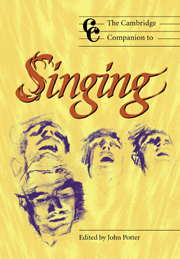Book contents
- Frontmatter
- 1 Introduction: singing at the turn of the century
- Part I Popular traditions
- Part II The voice in the theatre
- Part III Choral music and song
- Part IV Performance practices
- 12 Some notes on choral singing
- 13 Ensemble singing
- 14 The voice in the Middle Ages
- 15 Reconstructing pre-Romantic singing technique
- 16 Alternative voices: contemporary vocal techniques
- 17 The teaching (and learning) of singing
- 18 Children's singing
- 19 Where does the sound come from?
- Notes
- Select bibliography
- Index
12 - Some notes on choral singing
from Part IV - Performance practices
Published online by Cambridge University Press: 28 September 2011
- Frontmatter
- 1 Introduction: singing at the turn of the century
- Part I Popular traditions
- Part II The voice in the theatre
- Part III Choral music and song
- Part IV Performance practices
- 12 Some notes on choral singing
- 13 Ensemble singing
- 14 The voice in the Middle Ages
- 15 Reconstructing pre-Romantic singing technique
- 16 Alternative voices: contemporary vocal techniques
- 17 The teaching (and learning) of singing
- 18 Children's singing
- 19 Where does the sound come from?
- Notes
- Select bibliography
- Index
Summary
There is a very large repertoire for choral societies and larger choirs ranging from the late Baroque of Bach and Handel, through the Romantics such as Mendelssohn, Reger and Brahms to composers of the present day. Although there are professional choir singers, the numbers involved usually mean that most people are singing for fun, though ‘fun’ in this case may mean a great deal of commitment and effort. Amateur singers are enthusiasts, often men and women who could have become professionals but for various reasons ended up pursuing singing as a hobby (which often begins after a hard day's work).
The singer
Singing in a large choir is very demanding for the singer. It may seem easy, with many singers on each part, but it is essential that the individual singer's resources are fully used in order for the complete ensemble to sound well as a choir. One of the most difficult problems is controlling your own voice when you may be sitting next to some one whose voice is very different from your own. It helps to think of a kind of mutuality of sound, each voice blending together, perhaps reducing the vibrato so that you can clearly hear each other's pitch. Consider the style of music that you are singing. Although the choir may have its own distinctive sound, the best choirs have a keen awareness of style: Bach, for example, will need to be approached with a straighter sound than the full-blooded singing appropriate for Richard Strauss.
- Type
- Chapter
- Information
- The Cambridge Companion to Singing , pp. 149 - 157Publisher: Cambridge University PressPrint publication year: 2000
- 1
- Cited by

